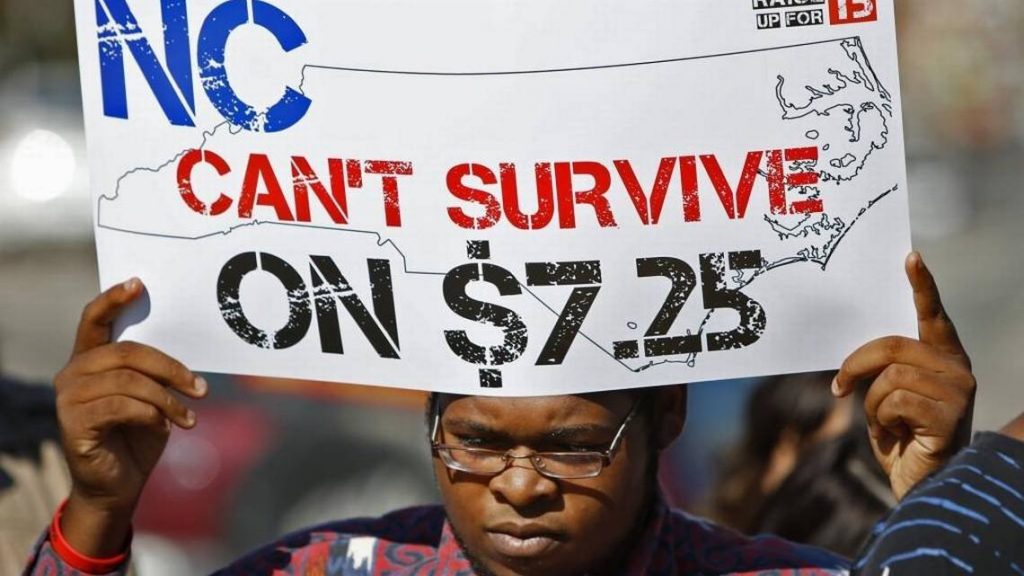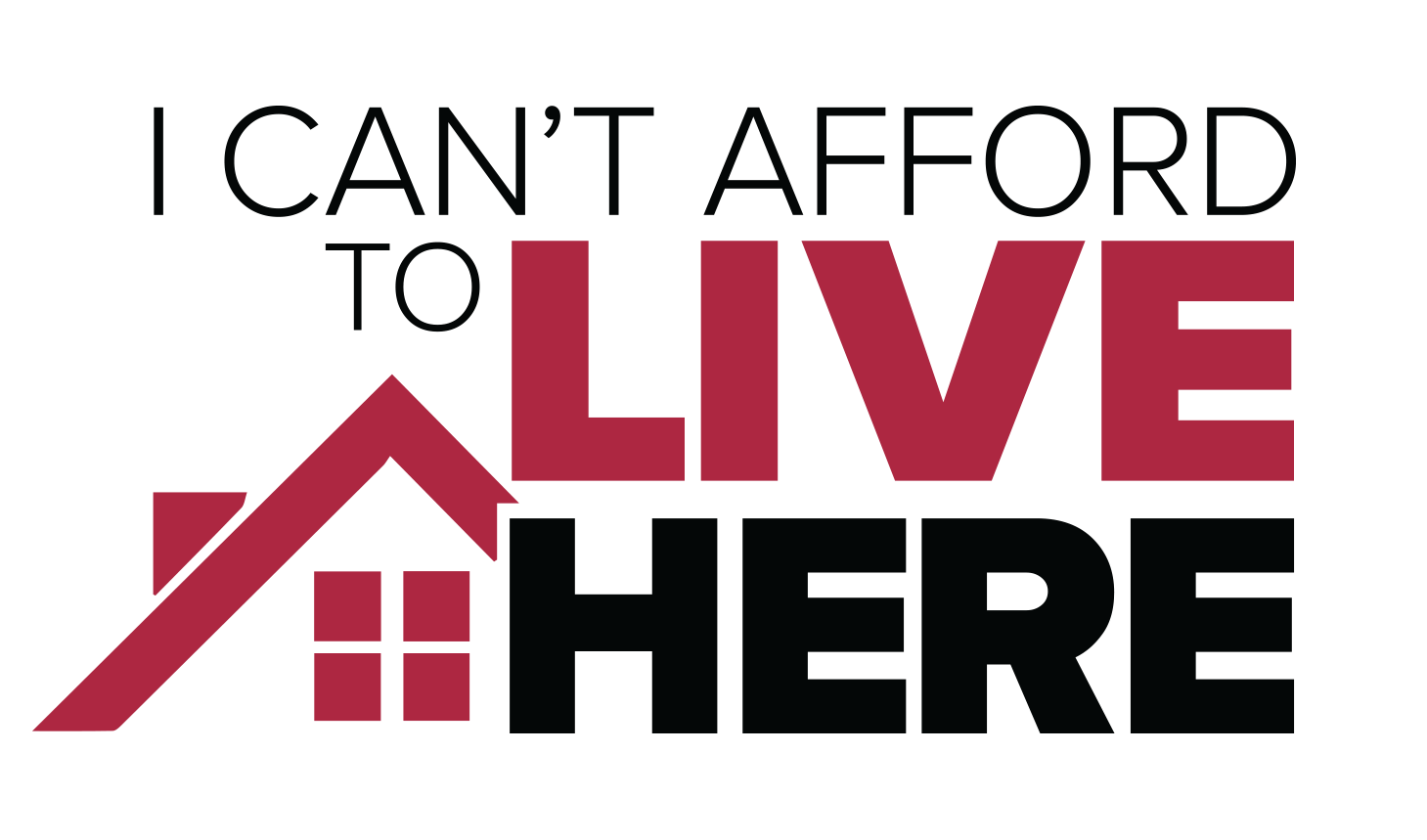
By Pam Kelley
Charlotte Journalism Collaborative
‘One Job Should Be Enough’
Workers can’t afford housing if they don’t make a living wage. But as Charlotte seeks to remedy its affordable housing shortage, it has largely ignored the issue of poverty wages. Could a community living-wage project be part of Charlotte’s affordable housing solution?
Consider Charlotte’s affordable housing crisis as a math problem. Housing costs are too high. Wages are too low. How do you solve it?
So far, the community has focused on half the equation, raising and spending tens of millions to build and subsidize affordable units, while largely ignoring the issue of poverty-wage jobs.
Many housing advocates say that’s a mistake. In a city where low-paying jobs are a significant and growing part of the economy, Charlotte can’t build its way out of this problem, they say. The community needs to address wages, too.
“The easiest thing to do is look at a graph,” says Peter Kelly, co-founder of Equitable Communities CLT, a nonprofit that advocates for affordable housing and economic equity. While rents have climbed, pay has remained nearly flat. It isn’t just a supply problem, he says. “It’s income.”
“We do just have to be able to flat-out name it,” says Justin Perry, co-founder of OneMECK, an advocacy group working for equal opportunity in Charlotte-Meckenburg Schools. “We have to significantly increase the minimum wage. And if we’re not willing to do that, then we have to acknowledge we’re not willing to lead.”
North Carolina’s minimum is the same as the federal minimum wage – $7.25. But in Mecklenburg County, a living wage – the hourly pay required to cover necessities – is significantly higher. The MIT Living Wage Calculator puts it at $12.58 for a single adult, $24.69 for an adult with one child. Other living-wage models produce even higher minimums.
Unlike many cities, Charlotte doesn’t have the power to set a higher minimum wage for local businesses. It would need legislative approval, and the Republican-controlled General Assembly has opposed increasing the current minimum.
There’s one voluntary strategy, however, that the Charlotte-Mecklenburg Opportunity Task Force recommended in 2017 as a way to address Charlotte’s inequities: Encourage employers to raise wages and improve benefits for their lowest-paid employees.
So far, Charlotte hasn’t pursued this idea in a coordinated way. But other N.C. cities have. They’ve made higher wages a communitywide goal with the help of nonprofit living-wage projects. Projects serving Buncombe, Transylvania, Durham and Orange counties have helped thousands of workers earn higher pay through programs that certify living-wage businesses.
They also work to publicize the importance of higher wages. In Durham, for instance, living wages have “become part of the housing affordability conversation,” says Matt Kopac, founder of the Durham Living Wage Project.
‘One job should be enough’
Since 2014, when Charlotte learned it placed last in an economic mobility ranking of 50 of America’s largest cities, the city has often been characterized as two Charlottes – one prosperous, one poor. UNC Chapel Hill’s Gene Nichol, a law professor whose 2018 book, “The Faces of Poverty in North Carolina,” includes a chapter on Charlotte, has found this an apt image when it comes to wages.
Charlotte, like the rest of America, has lost manufacturing jobs that once provided middle-class wages. And while the city has attracted thousands of high-earning jobs, three low-wage industries – retail, administrative services and accommodations and food service – make up a large and growing share of the city’s economy, Nichol says.
In Mecklenburg County, 32 percent of workers – 221,630 – are employed in occupations that pay a median wage of less than $15 an hour, according to an N.C. Justice Center analysis of federal employment data.
Meanwhile, median rents for two-bedroom apartments top $1,000 a month. To keep rent costs below the recommended maximum 30 percent of income, a worker needs to earn $19.77 an hour – more than two and a half times the minimum wage, according to a recent study by the National Low Income Housing Coalition.
High-wage earners depend on low-wage workers for many services – child care, home-health care, grocery check-outs, food service, janitorial work. But these jobs, which may lack benefits or even full-time hours, don’t provide a ladder to the middle class. “They’re hard, demanding jobs, but they don’t have a way out of poverty,” Nichol says.
Since June, a group of these low-wage workers has provided Charlotte a glimpse of what it’s like to work full-time jobs that don’t cover necessities. They’re employees of the catering company for American Airlines, and they’ve been speaking at Charlotte City Council public forums, asking council members to help them win higher pay.
Their company, LSG Sky Chefs, assembles and delivers the food and drinks for Charlotte’s American Airlines flights. Though Charlotte is one of American Airlines’ most profitable hubs, these workers are the lowest-paid airline catering workers at any U.S. American hub, with starting pay at $8.40 an hour, according to Unite Here Local 23, the hospitality industry labor union that represents them.
This summer, some 11,000 LSG workers in more than 30 U.S. airports, including Charlotte’s, voted to strike. But because they’re covered by the Railway Labor Act, a law aimed at avoiding chaos in rail and airline industries, they can’t strike without permission from the National Mediation Board. It hasn’t granted a strike since 2010.
So Charlotte’s LSG workers are taking another approach, asking council members to use their leverage as landlords – the city rents airport space to both American Airlines and LSG Sky Chefs – to encourage the companies to approve higher wages.
One employee, Sylvester King, pointed out that the airport and American Airlines were very profitable, but after four years at LSG, he was making $9.85 an hour and living with friends.
Another, Bobby Kirkpatrick, has worked for the company for 38 years as a driver, delivering meal carts to flights. He earns less than $16 an hour and makes ends meet by working overtime. But he’s still doing better than co-workers who survive with the help of food stamps and second jobs. “It seems that our moral compass has been bent backwards,” he told council members. “One job should be enough.”
Council members have expressed support for workers and met with officials at American Airlines, which decides whether to accept a higher-cost contract with LSG Sky Chefs. So far, nothing has changed.
A spokesperson for American Airlines declined comment, referring questions to LSG Sky Chefs. In a statement, the catering company says it has offered wage improvements and remains “committed to negotiating in good faith with the help of a federal mediator.”
Stuck at $7.25
Poverty wages aren’t just a Charlotte problem, of course. Congress hasn’t raised the $7.25 federal minimum wage for 10 years, the longest period since it was created in 1938. Until the early 1980s, a full-time minimum wage job was enough to keep a worker with a child above the poverty line, according to the Economic Policy Institute, a liberal-leaning think tank. Not so today. If the 1968 federal minimum wage had kept up with inflation, it would now be nearly $12.
A 2016 Economic Policy Institute study found that once the elderly are excluded, more than 70 percent of beneficiaries of public safety-net programs such as food stamps, subsidized housing and Medicaid are working individuals or families, not unemployed. Nearly half of those recipients work full time. With corporate profits and executive pay at record levels, “it is appropriate to question whether employers are effectively passing off a portion of their societal responsibilities on to taxpayers,” writes Matt Cooper, an economic analyst with the institute.
With the federal minimum wage stagnant, 29 states and Washington D.C. have raised their minimums. Forty-four cities and counties have also pushed local minimums beyond state minimums. In some places, they’re $12 or higher. If you average all federal, state and local minimums, the New York Times reported recently, the actual U.S. minimum for 2019 is $11.80.
In North Carolina, however, it remains $7.25. When CNBC recently published “The 10 worst cities for minimum wage workers,” North Carolina was the only state with multiple cities – Greensboro, Raleigh and Charlotte – on the list. The story, which compared minimum wages and living costs in 75 large U.S. cities, ranked Charlotte No. 1 – the worst.
Some N.C. cities and counties, including Charlotte and Mecklenburg, have raised minimums for their own workers. Last year, North Carolina’s Republican-led legislature also raised the minimum to $15 for most state employees.
But the legislature has balked at taking up minimum-wage bills introduced by Democrats, including one in the House Finance Committee that would gradually raise the state’s minimum wage to $15 by 2024. “We tried to strike a middle ground – recognizing small businesses, especially in rural North Carolina, need time to adjust,” says Allan Freyer, director of the Workers’ Rights Project for the liberal-leaning N.C. Justice Center, a research and advocacy nonprofit trying to eliminate poverty in North Carolina.
The Finance Committee’s three Republican senior chairs – representatives Julia Howard, Mitchell Setzer and John Szoka – didn’t respond to requests to discuss the bill.
Opponents of wage increases, such as Raleigh’s conservative-leaning John Locke Foundation, cite a 2014 report in the Journal of Labor Research that predicts raising North Carolina’s minimum to $10.10 would kill as many as 50,000 jobs. Urban areas with low unemployment, like Charlotte, could weather the hit, but it would be hard on rural areas, says Jon Sanders, the foundation’s director of regulatory studies.
For decades, some economic research using statistical modeling has found that minimum wage increases lead to job losses. That’s one reason the Charlotte-Mecklenburg Leading on Opportunity Task Force, while encouraging local employers to raise wages and benefits, didn’t include a minimum wage increase among its recommendations for combating inequality. “Research is split on the short-run impact of a minimum wage increase for workers’ employment levels and overall pay,” the report says.
But some recent studies examining the real effects in communities that raised minimum wages have found the opposite – that they lifted low-wage workers out of poverty with limited harm to the broader economy. Davidson College’s Clark Ross, a labor economist, says U.S. economists generally agree current labor market conditions could sustain at least a modest federal increase. “For many economists,” he says, “the benefit to low-wage workers would certainly justify this increase.”
It’s unclear what position the Charlotte Executive Leadership Council, a group of prominent local CEOs, takes on the issue of raising wages. A group spokesperson didn’t respond to a request for comment.
Sustainable jobs in Asheville
Stroll a few streets in Asheville’s business district and you’ll likely spot a sticker on the door or window of some shops and restaurants – “Living Wage Certified.” This certification means the business pays its employees a minimum of $13.65 an hour, or $12.15 with employer-provided health insurance.
This rate is what the nonprofit Just Economics of Western North Carolina calculates as living-wage pay in Buncombe County – the least one person working a full-time job needs to afford necessities, including housing, without public assistance. The Durham Living Wage Project sets the wage at $15, or $13.50 with health insurance. Orange County Living Wage puts it at $14.25, or $12.75 with health insurance.
Living-wage advocates say the benefits of these voluntary programs go far beyond pay. A living wage can mean the difference between housing and eviction. Higher wages also pump money into the community, says Susan Romaine, who directs the Orange County Living Wage Project. Most additional wages are spent locally “on things that are put off, that are desperately needed, everything from getting a haircut, to fixing a car, to getting a faucet repaired,” she says.
Certification raises payroll costs, and may cut profits. But it can lower other expenses, says Vicki Meath, executive director of Just Economics, the nation’s largest living-wage certification project, with about 450 participating businesses. “When you pay people more,” she says, “you have reduced turnover, and you spend less on recruitment and training.”
That’s been the experience at Carrboro’s Townsend Bertram & Co., a living-wage certified outdoor outfitters company. “All around, it’s made our staffing so much more effective,” General Manager Taylor Dansby says. “If people feel valued, they give you more.”
It also means that workers no longer need second jobs. At Asheville’s living-wage-certified Blue Dream Curry House, most employees make more than the $13.65 minimum required for certification, General Manager Joel Bishop says. In addition to tips, servers earn $7.25 – not the state’s minimum $2.13 hourly wage for tipped employees. Kitchen workers with the skills to work every station earn $18 an hour.
Certification yields good publicity, attracting higher-quality job applicants and customers who want to support living wages. Among Orange County businesses, certification creates positive peer pressure, a feeling of “if they can do it, maybe we can do it,” Romaine says.
Just Economics offers a toolkit that communities can use to start their own programs. Meath has received inquiries from people in Charlotte, but she says no group has decided to spearhead a living-wage project.
What would Henry Ford do?
Charlotte’s tight job market has recently been nudging lower-end wages upward. Some employers are paying minimums of $15 an hour. Bank of America is at $17. “Wages are escalating at the highest rate since we came out of the recession,” especially on the low end, says Kenny Colbert, CEO of The Employers Association, a Charlotte-based human resources consulting company. Employers who hired workers at $7.50 an hour a couple of years ago may now offer starting pay of $8, $9 or higher, Colbert says.
But that’s still not a living wage, the N.C. Justice Center’s Freyer says. He hopes N.C. voters will make increasing the state’s minimum a top issue in the 2020 elections.
Some local activists, meanwhile, want businesses to embrace the wage issue. “It would be great to see the various business leaders come together with a commitment to take substantive action – a tangible financial commitment to their low-wage employees,” Justin Perry says.
“Take a look at what Henry Ford did,” says the Rev. Ricky Woods, pastor of First Baptist Church West. “When Henry Ford raised the wages for the workers on his assembly line, capitalists thought it was the end of the world.” Ford raised wages to $5 a day in 1914 – the equivalent of $128 today – to reduce absenteeism and employee turnover. It worked, and it helped create an industrial middle class. As a byproduct, workers could afford to buy the cars they helped build.
“In an effort to maximize returns for shareholders, we’ve forgotten that,” Woods says. “That’s the kind of business thinking that we need now: What investments can we make that will lead to sustainable growth for the community?”
Pam Kelley, a Charlotte journalist, is the author of “Money Rock: A Family’s Story of Cocaine, Race, and Ambition in the New South.” This story was produced by the Charlotte Journalism Collaborative, a partnership of six media companies working together in an effort started by the Solutions Journalism Network and funded by The Knight Foundation.












